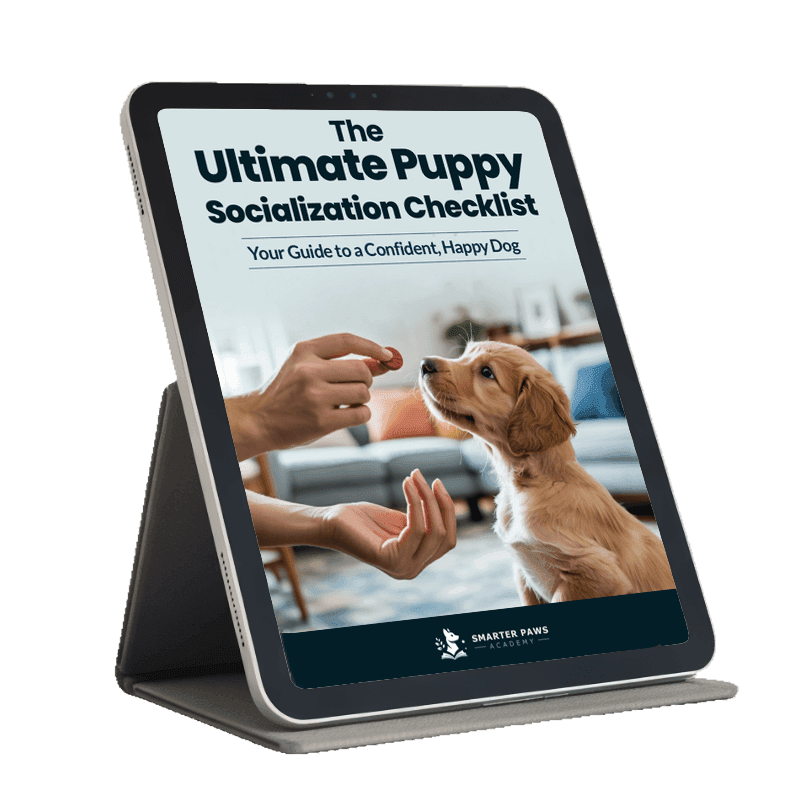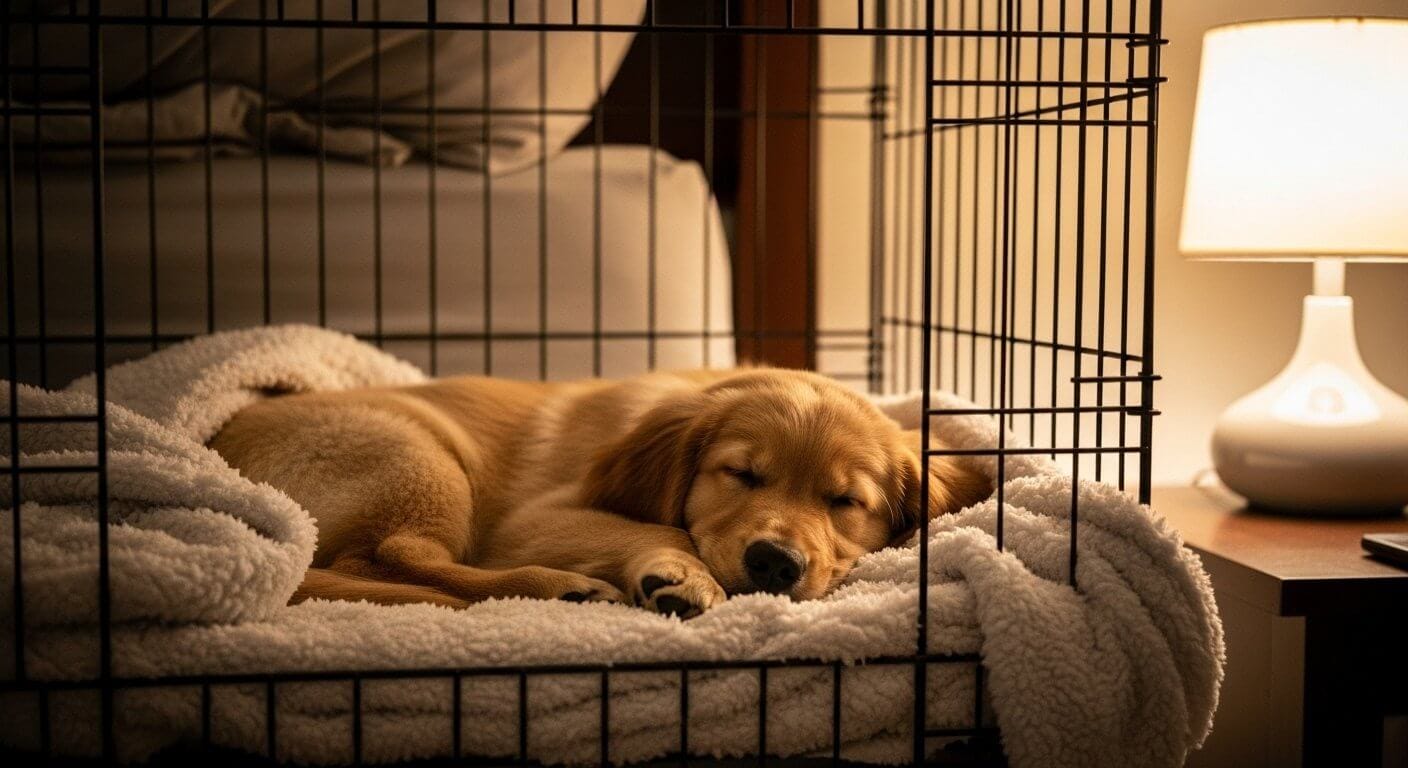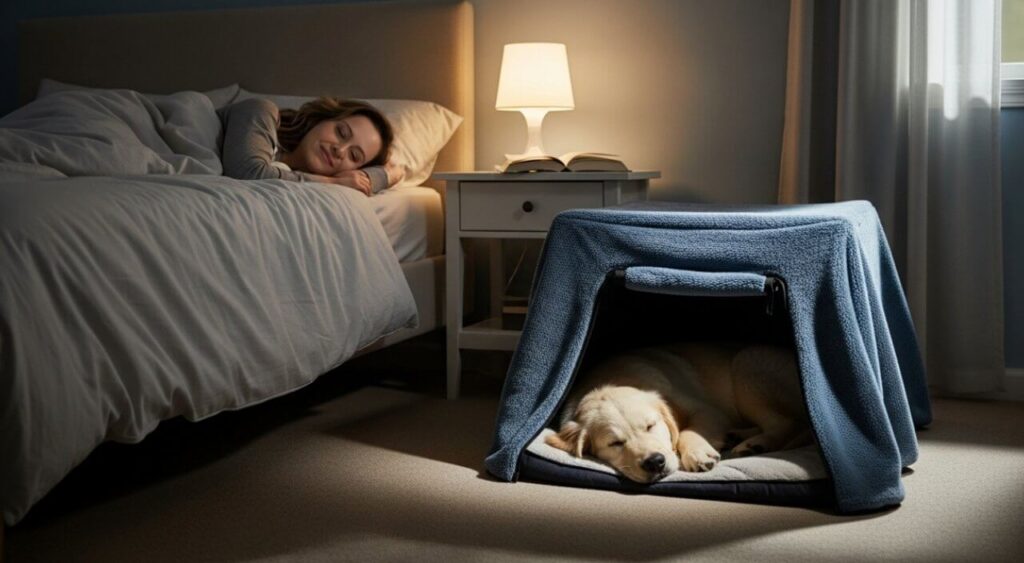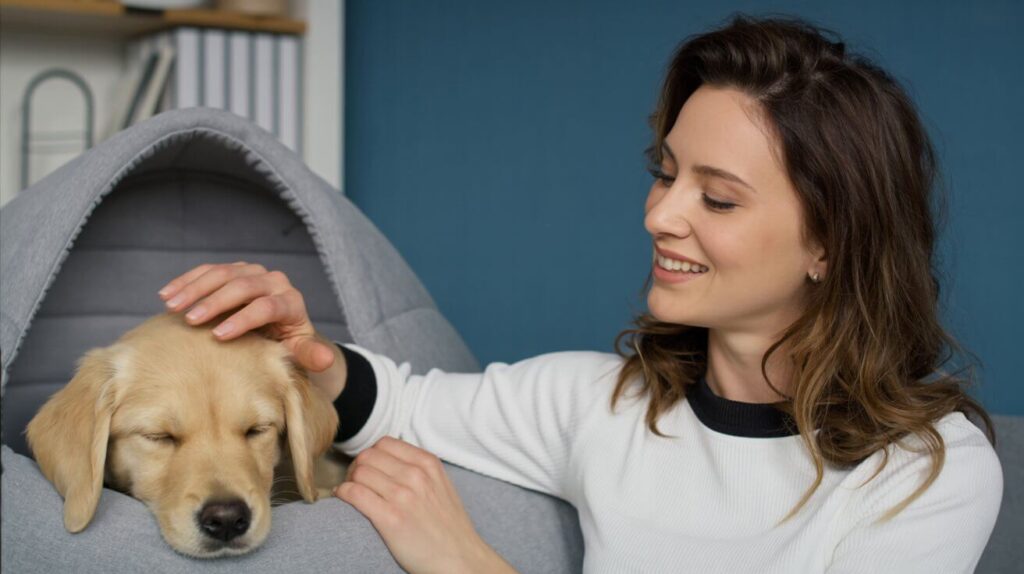That sharp, needle-like pinch on your hand, the constant tugging on your pant leg if you’re dealing with a biting puppy, I want you to know two things: you are not alone, and this is completely solvable. My name is Sandie Calloway, and the number one issue new puppy owners call me about, often in a state of sleep-deprived panic, is how to stop puppy biting.
I want to reassure you: your puppy is not being “bad” or aggressive. They are being a normal puppy, exploring the world with their mouth the only way they know how. The solution isn’t about punishment or “discipline”; it’s about patiently teaching them a new set of rules for their new human family. This guide will give you a simple, humane, and incredibly effective 5-step plan to transform your little land shark into a gentle, well-mannered companion.
Smarter Paws Academy is reader-supported. When you buy through links on our site, we may earn an affiliate commission at no extra cost to you. As an Amazon Associate, I earn from qualifying purchases. Thank you for your support!
Important Behavior Disclaimer
The information in this article is for educational purposes only and is based on my experience as a certified dog trainer. It is not a substitute for professional veterinary or behavioral advice. If you believe your puppy is showing signs of true aggression, please consult a qualified professional.
Key Takeaways: Puppy Biting
- It’s Normal Behavior: Puppy biting, or “mouthing,” is a natural part of development. It’s how puppies explore, play, and learn. It is almost never a sign of aggression.
- The Goal is Teaching, Not Punishing: The most effective way to stop puppy biting is to teach “bite inhibition”—the skill of controlling mouth pressure. Punishment creates fear and can make biting worse.
- Management is Key: The core solution involves managing your puppy’s environment and consistently redirecting their mouth from your skin and clothes onto appropriate chew toys.
Prefer to Listen? An Audio Overview
For a conversational deep dive into this topic, press play below for my complete audio discussion on puppy biting.
Runtime: 1 minute 54 seconds
View Full Audio Transcript
Narrator: Welcome to the Smarter Paws Academy audio overview. Today, we’re tackling one of the most common and painful challenges of puppyhood: how to stop puppy biting. Sandie, what’s the first thing a frustrated new owner needs to hear?
Sandie Calloway: The first thing is, take a deep breath! Your puppy is not being bad or aggressive. Puppy biting, or mouthing, is a completely normal and necessary part of their development. It’s how they learn to use their mouth gently. Our job isn’t to punish them for it, but to be their patient teacher.
Narrator: So, what’s the biggest mistake you see owners make when trying to “discipline” a puppy for biting?
Sandie Calloway: The most common mistake is using physical punishment, like holding their mouth shut or pinning them down. This is based on outdated “alpha” theories and it’s incredibly damaging. It doesn’t teach the puppy what to do instead; it just teaches them to be afraid of your hands, which can create much bigger problems down the road.
Narrator: So what is the correct, humane solution?
Sandie Calloway: The solution is a two-part process: management and redirection. Management means setting up your puppy’s environment so they can’t make mistakes, like using a playpen. Redirection is the active part—consistently teaching your puppy to put their mouth on an appropriate chew toy instead of your skin or clothes.
Narrator: So you’re not stopping the chewing, you’re just changing the target.
Sandie Calloway: Exactly! The urge to chew is a biological need, especially when they’re teething. By redirecting that urge onto a toy and praising them for it, you’re teaching them a critical life skill. You’re not just stopping a bad habit; you’re building a foundation of trust and clear communication that will last their entire life.
Table of Contents
Why is My Puppy Constantly Biting Me?
First, take a deep breath. Your puppy’s biting is not a sign that they are mean or will be aggressive. As the ASPCA explains, mouthing is a normal, critical part of their development. They are essentially a baby exploring the world, and their primary tool for exploration is their mouth.
There are a few key reasons for this behavior:
- Play: This is the most common reason. Puppies bite their littermates to initiate play, and they are simply trying to do the same with you. They don’t yet know that human skin is far more sensitive than furry puppy skin.
- Teething: Just like human babies, puppies experience discomfort as their adult teeth come in (usually between 3 and 6 months of age). Chewing helps relieve this pressure, a topic we cover in our complete puppy schedule guide.
- Exploration: Puppies use their mouths to learn about textures, shapes, and what is and isn’t edible. Your pant leg is just another interesting texture to investigate.
- Attention-Seeking: If your puppy learns that nipping your hand makes you yelp and look at them, they may start doing it to get your attention.
Understanding these underlying reasons is the first step to solving the problem with compassion instead of frustration.

How Can You Tell if Puppy Biting is Aggressive?
This is the number one fear I hear from puppy owners. The good news is that true aggression in young puppies is incredibly rare. 99% of what you’re seeing is normal, albeit painful, puppy mouthing.
Here’s how to tell the difference by looking at their body language:
- Normal Puppy Mouthing: The body is loose and wiggly, with a relaxed posture. The bites happen during play and aren’t accompanied by threatening vocalizations. The puppy is easily distracted by a toy and their overall mood is happy and energetic.
- Potential Aggression (Red Flags): The puppy’s body becomes very stiff or freezes right before biting. The bite is accompanied by a deep, guttural growl or snarl (not playful growling). You might see “whale eye” (the whites of their eyes are very visible) or a tense mouth with lips pulled back. They may also guard resources like food or toys.
If you see these red flags consistently, it is crucial to contact a certified professional dog trainer or veterinary behaviorist for an in-person evaluation. For everyone else, let’s move on to our positive plan.
How to Stop Puppy Biting: A Humane 5-Step Plan
This plan is based on the proven, science-backed principles of teaching bite inhibition, as detailed by experts like Dr. Ian Dunbar. The goal is not to stop mouthing entirely overnight, but to teach your puppy how to be gentle.
Total Time: 21 days
Manage the Environment

Create a “puppy-proof” zone using a playpen or baby gates for times when you cannot actively supervise. Keep tempting items like shoes out of reach and use a leash indoors to prevent jumping and biting.
Redirect to a Toy

Always have an appropriate chew toy ready. The moment your puppy’s teeth touch your skin or clothes, immediately and calmly redirect their mouth onto the toy. Praise them enthusiastically when they chew the toy.
Use the “Yelp and Withdraw” Method

For hard bites during play, let out a sharp, high-pitched “Yelp!” and immediately let your hand go limp. Withdraw all attention for 10-20 seconds. This teaches the puppy that hard bites make the fun stop.
Implement a Brief “Time-Out”

If the puppy is over-excited and persistent, say “Too bad!” in a neutral tone and calmly lead them to their playpen for a 30-60 second time-out with a toy. This is a calm-down moment, not a punishment.
Reward the Calm

Actively look for moments when your puppy is being calm—lying at your feet or chewing their own toy. Calmly drop a small, high-value treat between their paws and say “Good settle” to reinforce the desired behavior.
How to Stop Puppy Biting Your Hands and Feet Specifically
When your puppy targets your hands and feet, the “Yelp and Withdraw” method is most effective. The moment you feel teeth, yelp, and pull your hand or foot away. Become completely still and boring. When they stop, you can re-engage with a toy. For persistent ankle-biting on walks, keeping a small tug toy in your pocket to redirect them onto can be a game-changer.
What to Do When Your Puppy Bites Your Clothes and Pants
This is usually an attention-seeking behavior. The best response is to completely remove the reward: your attention. The moment they latch onto your clothes, stop walking, stand perfectly still, and ignore them. The “game” becomes boring. Once they let go, you can praise them and continue your walk. For extreme cases, a non-toxic deterrent like Grannick’s Bitter Apple can be sprayed on pant cuffs to make them less appealing.
What Are the Best Tools to Manage Puppy Biting?
Having the right tools makes implementing the 5-step plan much easier. These are the items I recommend to all my new puppy clients, and they are all based on the positive principle of giving your puppy an appropriate outlet for their chewing needs.
The classic for a reason. This is my go-to for redirection. The soft rubber is perfect for a puppy’s teething gums, and you can stuff it with peanut butter or treats to make it an irresistible alternative to your hands.
For those times when your puppy just needs to settle down and chew, these all-natural bully sticks are a lifesaver. They are fully digestible and help satisfy that intense chewing urge during teething.
A tired puppy is a less bitey puppy. This puzzle toy is fantastic for mental stimulation. It makes your puppy think and work for their food, which helps reduce boredom-based nipping.
Management is the most underrated training tool. A playpen like this gives you a safe, puppy-proof space to put your pup for a short time-out when they get too mouthy, allowing them to calm down with a safe chew toy.
While redirection is always the first choice, a bitter spray can be a helpful tool. A quick spritz on your hands or furniture teaches your puppy that these items are unpleasant to chew, without causing any harm.
Harmful “Discipline” Methods You Must Avoid
You will find a lot of outdated advice online. To protect your relationship with your puppy, please avoid these methods at all costs:
- Holding their mouth shut or forcing a finger down their throat.
- Alpha rolling or pinning them down.
- Screaming “No!” or using physical punishment.
As the experts at the UC Davis School of Veterinary Medicine advise, these methods create fear and can lead to real aggression.

Puppy Biting by Age: What to Expect
- 8-12 Weeks: This is peak mouthing time. They are learning about their new world. Be extremely consistent with redirection.
- 3-6 Months: Teething begins. Biting may increase due to gum discomfort. This is the time to provide lots of safe chews and frozen toys.
- 6-12 Months: Biting should be significantly reduced as they’ve learned bite inhibition and their adult teeth are in. Any biting now is likely due to over-excitement or boredom.

Give Your Puppy the Best Start in Life
Don’t leave socialization to chance. Get our free, certified trainer-approved checklist for a step-by-step guide to raising a confident, happy dog.
From a Biting Puppy to a Gentle Companion
I know that living with a biting puppy can be exhausting. But remember that this phase is temporary, and you have the power to shape your puppy’s behavior through kind, consistent teaching. Every time you redirect your puppy from your hand to a toy, you are building trust. By following this positive, humane plan, you are not just stopping a bad habit you are building a stronger bond for life.
Frequently Asked Questions (FAQs)
At what age should puppies stop biting?
Most puppies have learned good bite inhibition and their mouthing has significantly decreased by 6-8 months old. However, this requires consistent training from you during the 8-week to 6-month period. Some breeds may continue to mouth longer, but the intensity should decrease dramatically with proper training.
How do you discipline a puppy who is biting?
“Discipline” shouldn’t mean punishment. The most effective approach is positive redirection: immediately offer an appropriate chew toy when they bite, use the “yelp and withdraw” method for hard bites, and provide brief time-outs for over-aroused puppies. Never use physical punishment as it can create fear and worsen the behavior.
Should I hold my puppy’s mouth shut when biting?
Absolutely not. Holding a puppy’s mouth shut is an outdated and harmful technique that can create fear, damage your bond, and potentially lead to real aggression. It doesn’t teach them what to do instead and goes against modern, science-based positive reinforcement training methods.
How do I get my puppy to stop biting my feet and pants?
For feet biting, use the “freeze and ignore” technique: stop moving completely the moment teeth touch your skin. For pants biting, stop walking and stand still. Once they release, redirect to a toy. Keep a tug toy in your pocket during walks for immediate redirection. For persistent cases, you can apply a bitter apple spray to pant cuffs.
What should I do if my puppy bites me and draws blood?
First, clean the wound thoroughly with soap and water. If it’s deep, seek medical attention. For training, this indicates your puppy needs more work on bite inhibition. Go back to basics: more frequent redirection to toys, use the yelp method for all bites, and consider using deterrent sprays on your hands during training sessions.
Is it normal for a 3 month old puppy to bite?
Yes, this is completely normal and expected behavior. At 3 months, puppies are in the peak of their teething phase and exploring the world intensely with their mouths. This is actually the critical period for teaching bite inhibition, so consistent training now will pay off tremendously as they grow.
My puppy won’t stop biting me, I’ve tried everything. What should I do?
When standard methods aren’t working, it usually means: 1) You need more consistency (everyone in the household must use the same techniques), 2) Your puppy needs more appropriate chew outlets, 3) They need more mental and physical exercise, or 4) There’s an underlying issue like teething pain. Consider consulting a certified trainer who can provide personalized guidance.








